Existing User Log In
New User Registration
Register for a free account to gain full access to the VGChartz Network and join our thriving community.



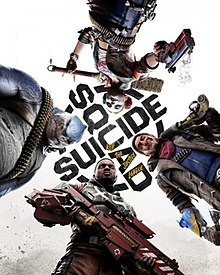

America - Front


America - Back

Rocksteady Studios
Shooter
| Owners: | 0 |
| Favorite: | 0 |
| Tracked: | 0 |
| Wishlist: | 0 |
| Now Playing: | 0 |
Reviewer's Note: Certain story critiques require me to post some SPOILERS. Read on at your own risk.
It's been nearly a decade since Rocksteady Studios released a game. Given that gap since either Batman: Arkham VR or Batman: Arkham Knight, no one else has risen to make players "feel like Batman." Trite as that saying has become, the sentiment still captures how the Arkham series perfectly interpreted The Caped Crusader's ferocity, movement, and… Scrooge McDuck's levels of wealth. Since Rocksteady's hung up the cowl, the question is: what does it now mean to feel like The Suicide Squad? Sadly, the answer seems to be functionally similar side-villains strapped to a live-service shooter. So, another premier single-player developer has been subjected to the corporate Games-as-a-Service (GaaS) mines and nets the typical result.
The one location in a worse place than Rocksteady's offices is downtown Metropolis. The sinister arch-villain Brainiac has invaded Earth and possessed most of The Justice League. Despite a couple of holdovers evading capture, Commander Amanda Waller isn't interested in twiddling her thumbs in the meantime. Desperate for help, she rifles through her itinerary to find four candidates locked in Arkham Asylum: Deadshot, Harley Quinn, King Shark, & Captain Boomerang. Given that she can't inveigle them into facing indomitable metahumans, she presents an ultimatum: kill The Justice League or the mini-bomb planted at their brain stems goes KA-BOOM! 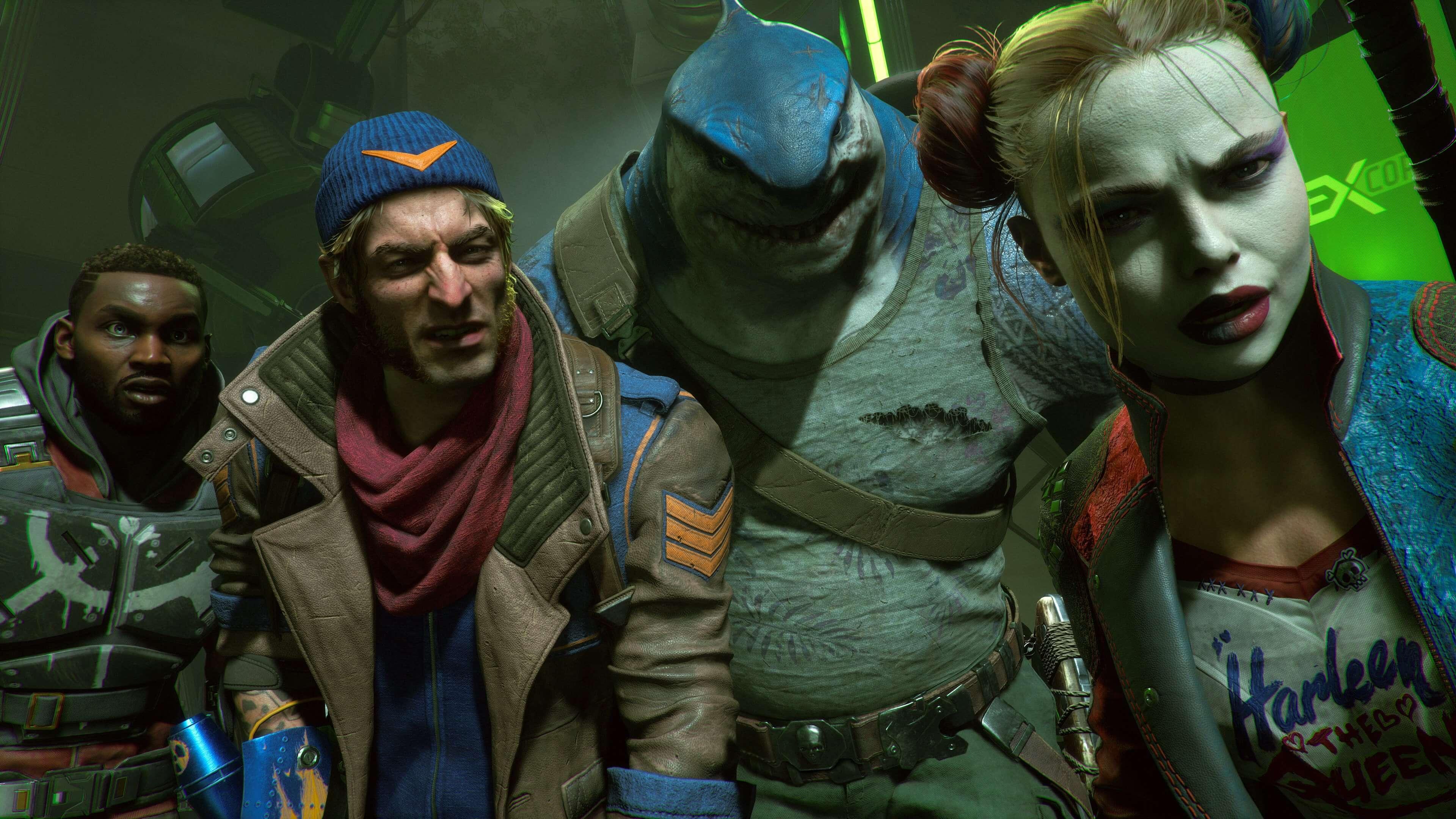
Given the subsequent narrative, I couldn't blame any of the team for taking the explosive way out. It's a shame too since Suicide Squad has a decent opening. Stepping into The Hall of Justice for exposition succinctly pairs in contrasting our newly-minted anti-heroes and establishing the stakes for Metropolis writ large, similar to home base in The Division. This structure is also used for seamlessly tying in how Arkhamverse's Batman/Bruce Wayne wound up here after saving Gotham. The way in which gameplay, atmosphere, and cutscenes are fused suggest these writers would have a smooth flight… until you play the rest.
Because it props up the live-service gameplay needs, the tempo of stopping the corrupted League relies on so much contrivance. The Sword of Damocles hanging over this spectacle comes back to questioning why The League wouldn't immediately kill this mortal crew. Sure, Wonder Woman being uncorrupted serves as a distraction, but there's such a tonal mismatch with radio calls about your alleged threat but then Brainiac's main solution is simply sending more purple minions to terrorize a vacant city; the slimmest of context in service to a GaaS foundation. You can see through the façade of randomized enemy spawns as you eventually acquire the big counter to each League member.
Looking past this misguided construction of story & gameplay, it's still stapled together with terrible writing from Ben Schroder, Sefton Hill, Ian Ball, and a small battalion of other scribes. There's a constant tonal mismatch because of this balance between Guardians of the Galaxy's reluctant heroes shtick and personalities of genuine killers – potentially even psychopaths. This push/pull is exacerbated in the moment-to-moment beats like if/when a former superhero meets their ultimate demise; every League member save Wonder Woman is horrendously denigrated in the name of cheap shock value. Even after internalizing that you (& maybe several friends) stepping into the shoes of raunchy anti-heroes, their actions & general attitude – save King Shark – come off as so petulant and ridiculous. Even if that's found within their original comics, that ethos feels so awkwardly welded here.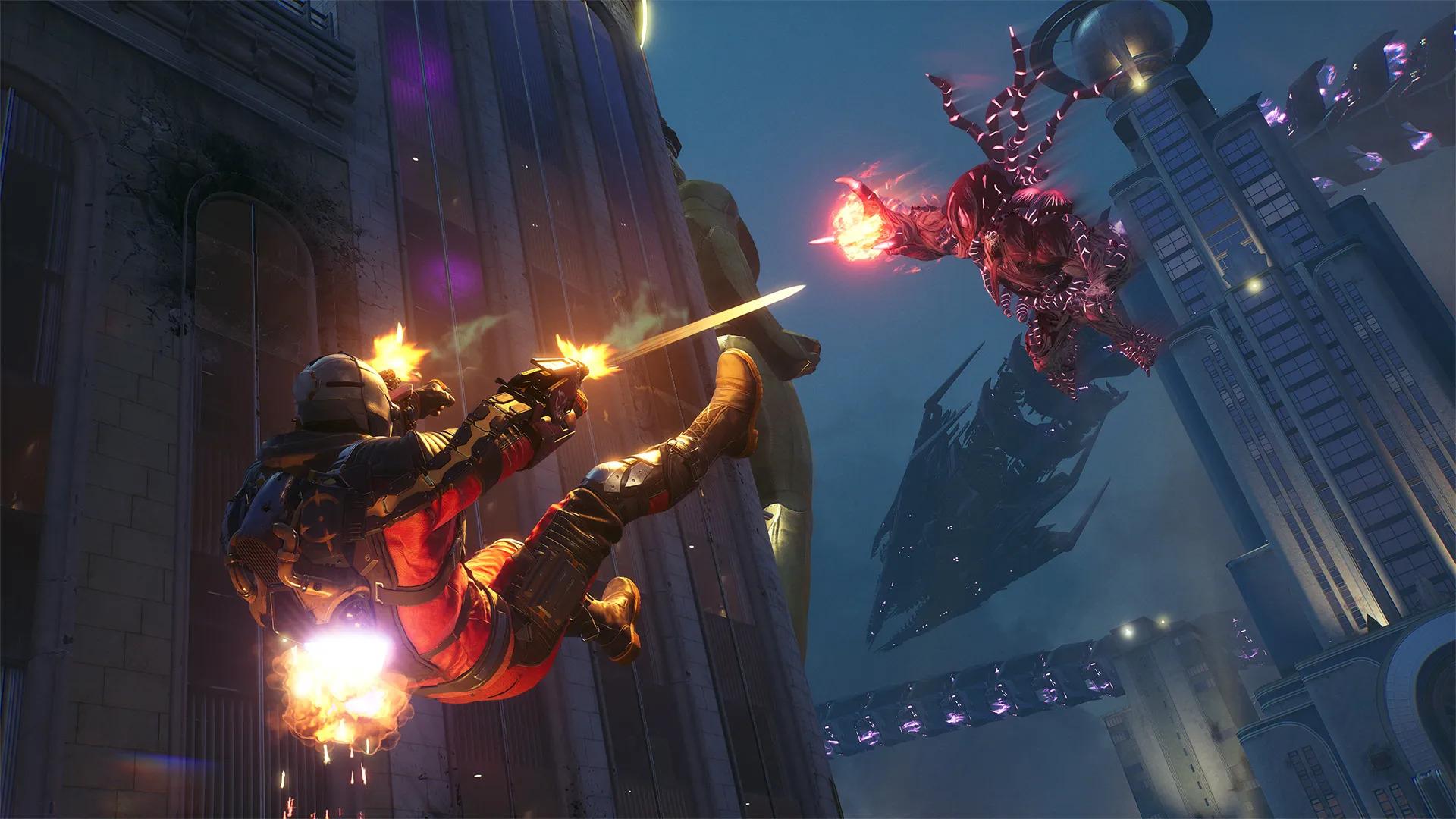
Despite the tome one could write (if so willing) for all of Suicide Squad’s writing mistakes, barely a jot can go against its presentation. On the technical side, Rocksteady's wizards impress with incredible facial animation work and a great sense of scale within cutscenes. Even though most of the script's sophomoric demands are little more than "be raunchy here" or "act angry," the deep roster of professional voice actors nail their respective roles. Tara Strong’s Harley Quinn perfectly captures why she's such a grating character, Samoa Joe's King Shark is a great Drax substitute, Debra Wilson's Waller isn't far behind Viola Davis' work, and the late Kevin Conroy's Corrupted Batman is chewing the scenery at every opportunity. When you mash these elements together, alongside adequate cinematic framing, the team can sporadically nail a good joke.
What makes Suicide Squad's narrative so off-putting stems back to this insane imbalance of industry-leading tech with some decent comedic hits smothered by everything else. It's hard to elucidate how such a typical 'save the world' story can be fumbled so hard, but it somehow accomplishes that through continuous awkward interactions and a skewed sense of morality. The writers had more interest in Harley sermonizing Batman (despite her own in-universe rap sheet) and despising her old licentious attire than actual character development. There's so many unnecessary, pathetic papercuts up to and including the game's post-mission report interrupting Conroy's post-credits eulogy. It's a story riddled with undercooked characters, tawdry shock value, lazy context, and a faux-conclusion all about priming players up for future updates. I had some choice words for the storytelling in Marvel’s Avengers, but at least it wasn't so contemptible.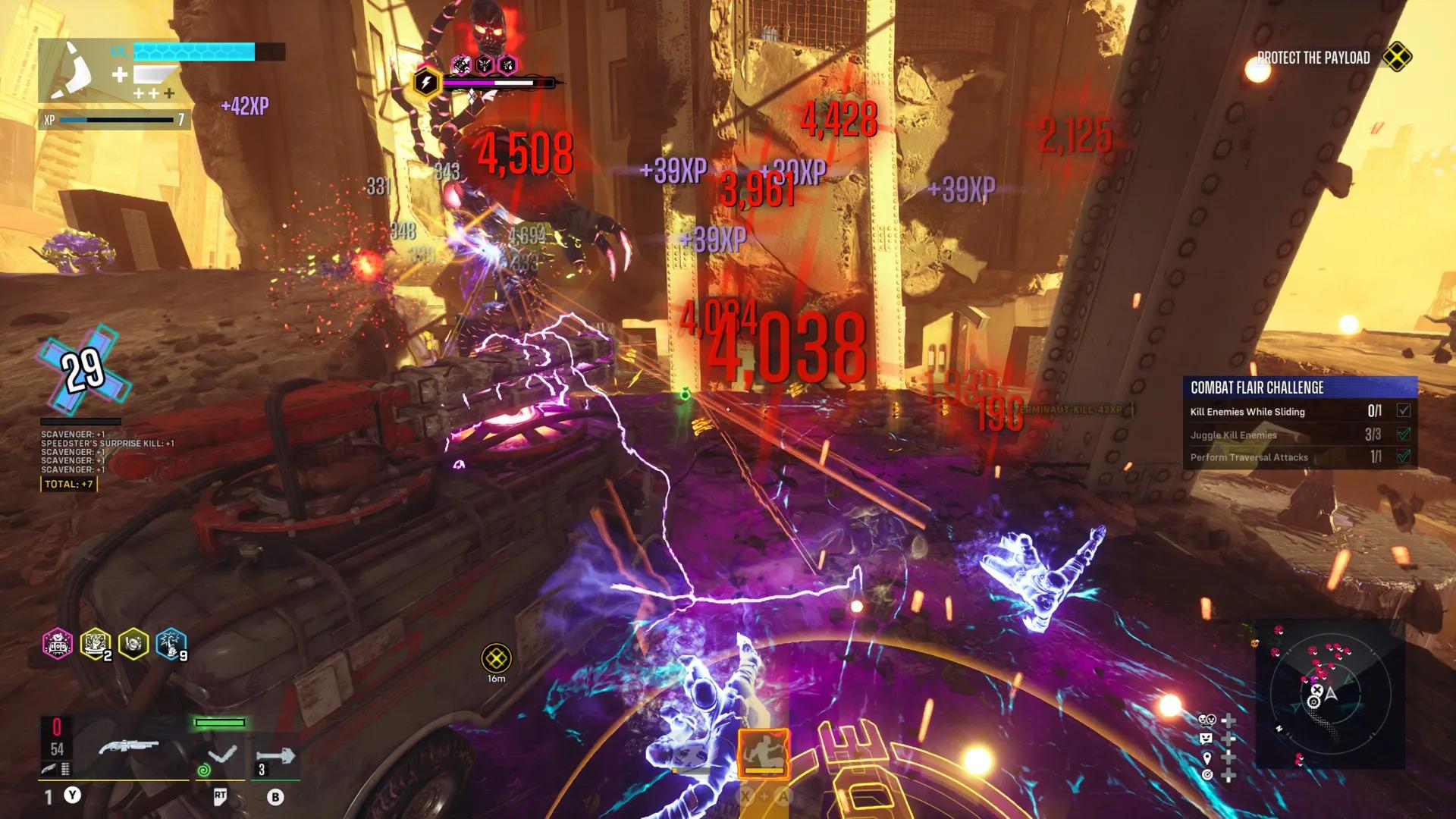
The pain doesn't stop there unfortunately; in fact, I'm willing to wager the biggest letdown will be in Rocksteady's storytelling, simply because few people seemed hyped for another live-service amalgamation. This is eminently apparent with the roster. When you think of such varied cast potential, like King Shark as a bruiser or Deadshot's marksman proficiency, you can imagine multiple moves and team dynamics being different while complimenting one another. The reality is less exciting: everyone is all about shooting all of the time, except for the barebones melee system. Now everyone is Deadshot but with disparate traversal mechanics and some gun classes being off-limits for certain characters.
The mechanical issues compound for this shooter sludge too. While, granted, it does technically work – the guns shoot, enemy damage indicators spurting out numbers taps into your lizard brain, and movement captures a nice flow state; past that, it ranks among the most generic third-person shooters. Outside of different weapon types and buffs with different-colored damage indicators, it's wild seeing how little personality you'll find across this entire arsenal. To combat that boredom, Rocksteady relies on some of the most garish UI pollution in recent memory. It's critical to note that not all UI elements are made the same; for example, one could point out beloved JRPG systems with large overwhelming interfaces. I may have some critiques for those too, but this deserves special attention not only for epileptic overdrive during bigger fights but the insane plurality of disparate fonts and colors simultaneously shoved down your eye-gullet. Consistent tutorial reminders several hours in, different trackers for various main or side objectives, damage indicators, and more make for such a visually cacophonous kaleidoscope.
You'd think I'm exaggerating over these interminable UI elements, but the options menu feels like filing taxes in selecting what can be enabled/disabled. Between those choices, plus available gameplay tweaks (like removing aim assist and whatnot), someone could contend these qualms are null and void. The issue is that level of choice overload can be a detriment. That's not to lump gaming's general expansion of accessibility options. No, I mean the design decisions like a bias towards auto aim/aim assist or the UI pollution. Even if there's some play in tweaking mechanics, the game design still has an implicit bias towards its default state. For instance: enemy vomit during big segments clearly indicates that quickly thinning the herd (a la Call of Duty's snappy ADS tricks) compliments this tempo, while there's an artificial difficulty spike if deliberately aiming without assists. The same also applies to potentially important player information within this UI. That's why having an off switch – while a nice respite – shouldn't allay those valid irritations.
I'm not sure where Rocksteady went wrong in de-emphasizing character creativity during combat when it remembered that for traversal. Early on, as every character is grabbing their kit at The Hall of Justice, Metropolis quickly opens up to experiment with each character. From Harley confiscating some of Batman's grapple tech, or King Shark's magical leaping abilities, you immediately feel a sense of reduced capabilities compared to Batman's glide or Spider-Man's swinging. Navigating the world feels more intentional. The reason this is also one of combat's best qualities comes back to that difference of approach between every squad member; and thanks to consistent movement & positioning it's really the one mechanic providing some kind of pulse.
For anyone familiar with the Arkham series, traversing through midday Metropolis is a total inversion of the darkened, dingy strolls through Gotham City. Even with a large purple-glowing metal skull hovering overhead, the colorful cityscape never feels ominous nor foreboding. That also contributes to the weak world design overall. I'm only coming off completing this a few days ago and virtually every area is escaping my memory. The problem is that for all the sedulous rendering by designers and world-builders, so much of your interaction is hopping from rooftop to rooftop. Literally 5% of total playtime occurs within enclosed spaces. Those times proved to be more memorable for one reason: you had to actively think about the space that you inhabited. Since virtually everywhere else is just one big instance of randomly spawning enemies, each locale just feels like window dressing.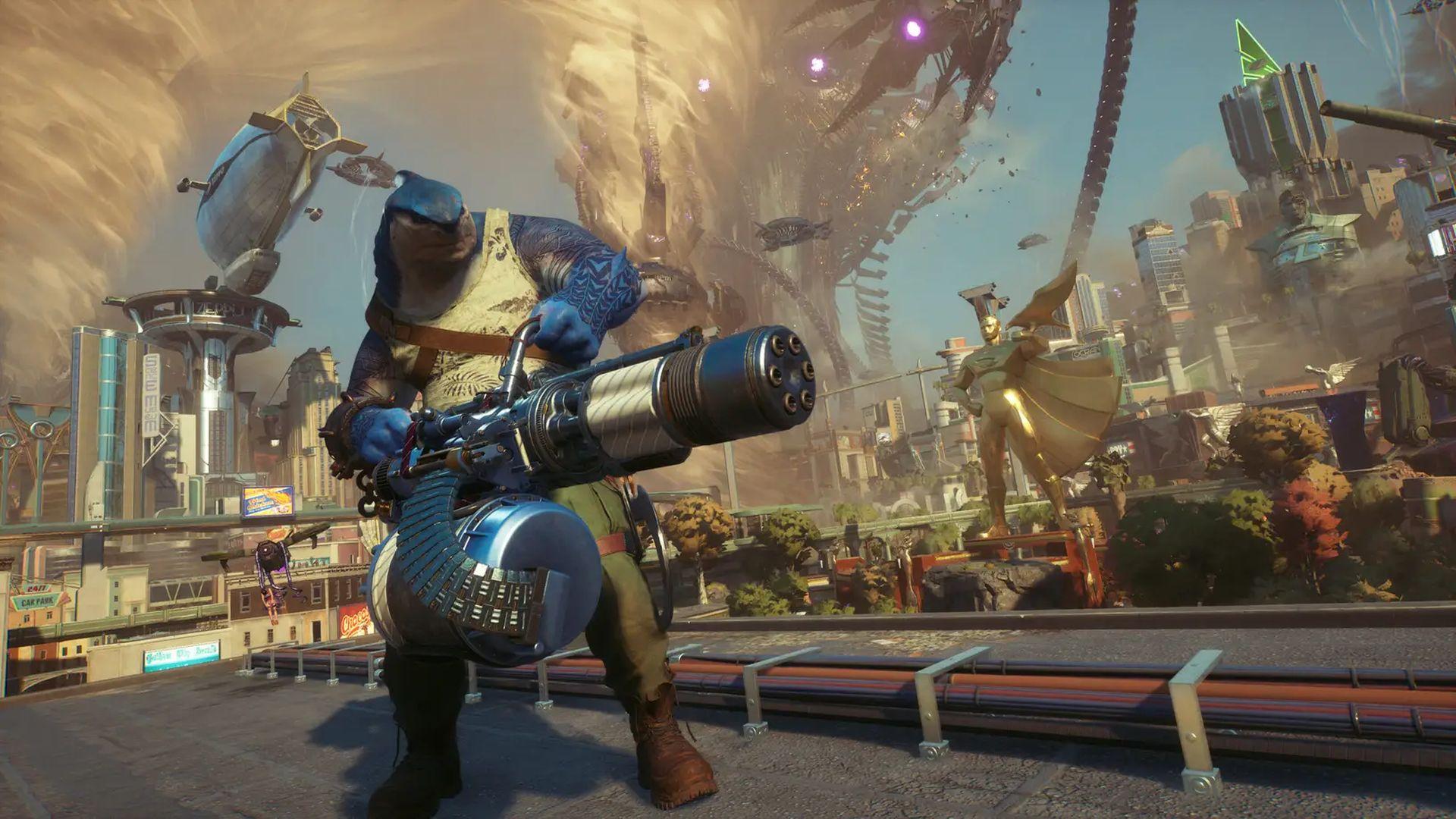
Harrying out attacks on Brainiac's forces becomes even more forgettable thanks to tedious mission design. It can't be emphasized enough just how much Rocksteady retreated to repetitive missions. It's either escorting a vehicle, bringing friendlies to a bus, dropping off tech tokens to a bus, destroying some batteries, or protecting fetal alcohol syndrome Poison Ivy's plants. Save for two moments of exploration tied with combat, everything is in service to shooting a bunch of baddies until you see Mission Complete. For the sake of emphasis: the likes of Redfall outclass this in variety. More disappointing than that, killing said Justice League is little more than shooting them a bunch while using shield breaker (the shooting equivalent of Batman's timed parry in Arkham titles); even more insulting, the final boss is basically a reskinned fight of The Flash from hours prior.
Although I typically avoid this, but some final thoughts could be better broken down with bullet points:
I could go on even further, but the main takeaway comes back to there being so many paper cuts beneath everything else.
As has become the modus operandi for live-service titles, the supplementary means of income besides the $70 buy-in price can be quite extraordinary. Besides the new AAA standard price point, there's also the $100 Deluxe Edition which offers some extra skins and weapons. With the latter, they're pay-to-win to the point of enabling you to disregard almost every standard drop in the first-half of the campaign. With the former, the corporate nickel-and-diming couldn't be more obvious. Sure, there are some nice skins, but their color-swaps are locked behind purchasable currency. By the time it's all said and done, you're paying for the game again to have the complete costume sets available at launch. I'm not a fan of that.
I'll say this: few live-service titles can dare to match Suicide Squad: Kill the Justice League in sheer mismanagement. From the stultifying design soullessly churned from an assembly line, to weird mechanical foibles that drag down what's nothing more than a middling shooter in principle, it's almost like one major corporate-driven decision damaged this concept in ways that can't be reconciled. All of which is poisoned further by a clichéd story littered with loathsome dialogue and misguided character moments. Yet it's also insane to think how much money was obviously shovelled into this. Whether it's impressive draw distances, detailed cutscenes, or decent post-launch polish, it's wild to think how many fundamental issues there are which can’t be blamed on a rushed release. Ironically, Rocksteady lived long enough to see itself become the villain.
Contractor by trade and writer by hobby, Lee's obnoxious criticisms have found a way to be featured across several gaming sites: N4G, VGChartz, Gaming Nexus, DarkStation, and TechRaptor! He started gaming in the mid-90s and has had the privilege in playing many games across a plethora of platforms. Reader warning: each click given to his articles only helps to inflate his Texas-sized ego. Proceed with caution.









